Acute Life Threatening Conditions Analysis: Nursing Assignment 401211
VerifiedAdded on 2022/12/23
|7
|1658
|81
Homework Assignment
AI Summary
This assignment analyzes a case study of a 75-year-old male, Mr. Kirkman, presenting with acute life-threatening conditions. The analysis begins with an examination of the pathogenesis of Mr. Kirkman's symptoms, including low blood pressure, elevated respiratory and heart rates, low oxygen saturation, fever, and abnormal urine characteristics, all indicative of a severe urinary tract infection (UTI) potentially progressing to sepsis and pyelonephritis. The assignment then proposes an evidence-based nursing strategy, emphasizing patient-centered care and fluid management to flush out bacteria and prevent further infection. Lastly, the assignment critically analyzes arterial blood gas (ABG) results, revealing metabolic acidosis, and relates these findings to the underlying pathogenesis, including high sodium, potassium and chlorine levels. The analysis concludes that the patient is suffering from diabetic ketoacidosis or metabolic acidosis and the UTI infection has already reached the kidney and caused Pyelonephritis.
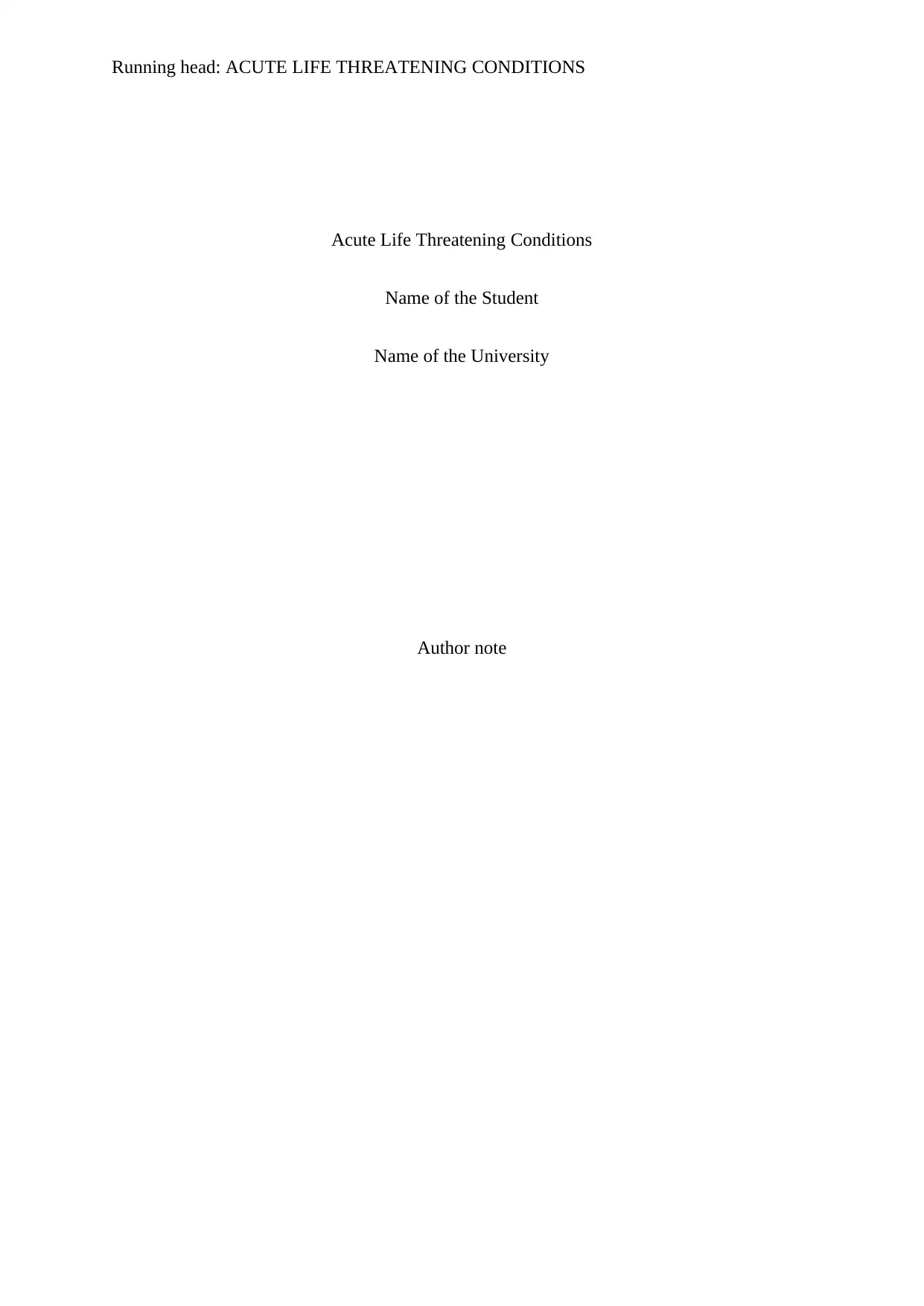
Running head: ACUTE LIFE THREATENING CONDITIONS
Acute Life Threatening Conditions
Name of the Student
Name of the University
Author note
Acute Life Threatening Conditions
Name of the Student
Name of the University
Author note
Paraphrase This Document
Need a fresh take? Get an instant paraphrase of this document with our AI Paraphraser
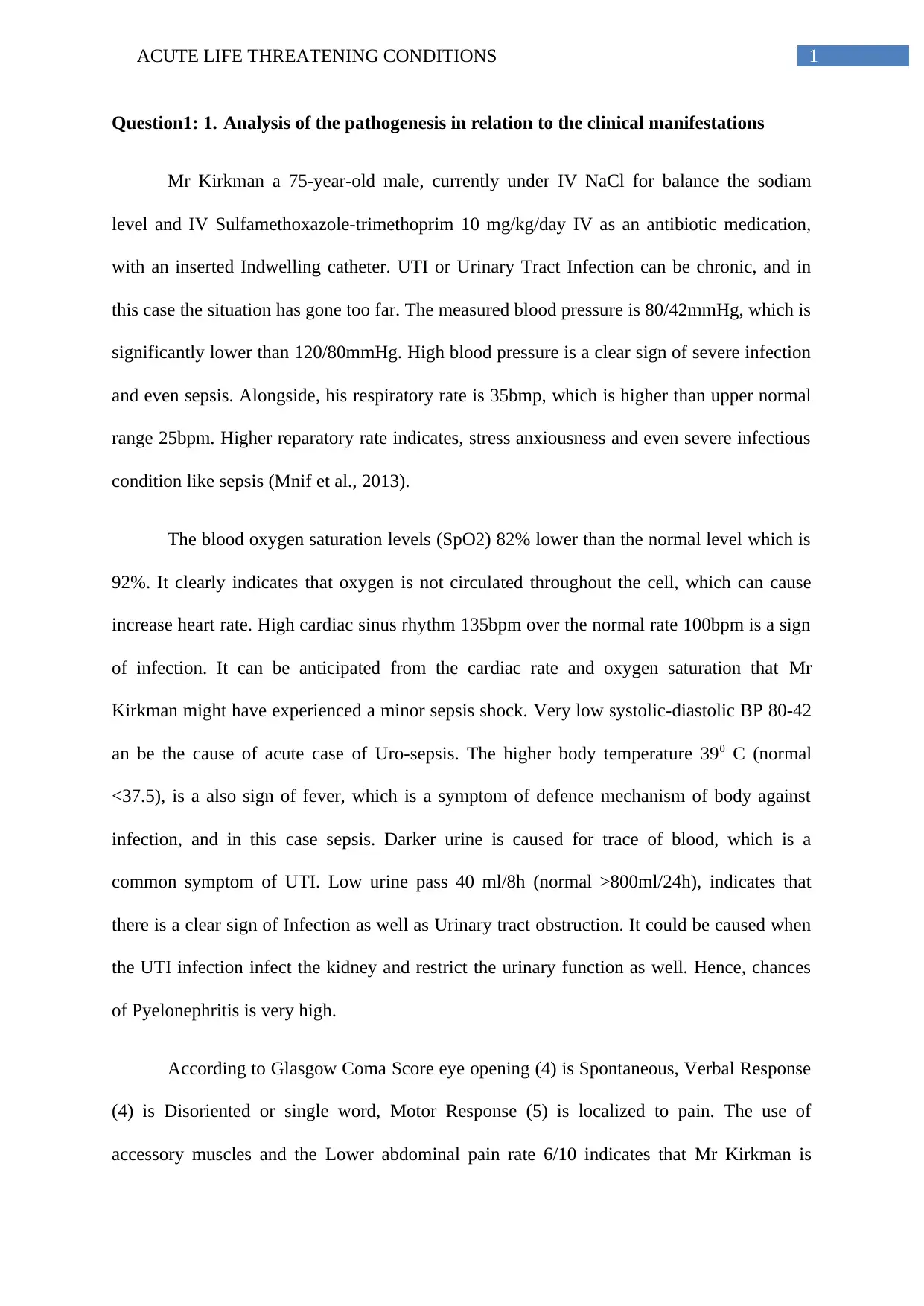
1ACUTE LIFE THREATENING CONDITIONS
Question1: 1. Analysis of the pathogenesis in relation to the clinical manifestations
Mr Kirkman a 75-year-old male, currently under IV NaCl for balance the sodiam
level and IV Sulfamethoxazole-trimethoprim 10 mg/kg/day IV as an antibiotic medication,
with an inserted Indwelling catheter. UTI or Urinary Tract Infection can be chronic, and in
this case the situation has gone too far. The measured blood pressure is 80/42mmHg, which is
significantly lower than 120/80mmHg. High blood pressure is a clear sign of severe infection
and even sepsis. Alongside, his respiratory rate is 35bmp, which is higher than upper normal
range 25bpm. Higher reparatory rate indicates, stress anxiousness and even severe infectious
condition like sepsis (Mnif et al., 2013).
The blood oxygen saturation levels (SpO2) 82% lower than the normal level which is
92%. It clearly indicates that oxygen is not circulated throughout the cell, which can cause
increase heart rate. High cardiac sinus rhythm 135bpm over the normal rate 100bpm is a sign
of infection. It can be anticipated from the cardiac rate and oxygen saturation that Mr
Kirkman might have experienced a minor sepsis shock. Very low systolic-diastolic BP 80-42
an be the cause of acute case of Uro-sepsis. The higher body temperature 390 C (normal
<37.5), is a also sign of fever, which is a symptom of defence mechanism of body against
infection, and in this case sepsis. Darker urine is caused for trace of blood, which is a
common symptom of UTI. Low urine pass 40 ml/8h (normal >800ml/24h), indicates that
there is a clear sign of Infection as well as Urinary tract obstruction. It could be caused when
the UTI infection infect the kidney and restrict the urinary function as well. Hence, chances
of Pyelonephritis is very high.
According to Glasgow Coma Score eye opening (4) is Spontaneous, Verbal Response
(4) is Disoriented or single word, Motor Response (5) is localized to pain. The use of
accessory muscles and the Lower abdominal pain rate 6/10 indicates that Mr Kirkman is
Question1: 1. Analysis of the pathogenesis in relation to the clinical manifestations
Mr Kirkman a 75-year-old male, currently under IV NaCl for balance the sodiam
level and IV Sulfamethoxazole-trimethoprim 10 mg/kg/day IV as an antibiotic medication,
with an inserted Indwelling catheter. UTI or Urinary Tract Infection can be chronic, and in
this case the situation has gone too far. The measured blood pressure is 80/42mmHg, which is
significantly lower than 120/80mmHg. High blood pressure is a clear sign of severe infection
and even sepsis. Alongside, his respiratory rate is 35bmp, which is higher than upper normal
range 25bpm. Higher reparatory rate indicates, stress anxiousness and even severe infectious
condition like sepsis (Mnif et al., 2013).
The blood oxygen saturation levels (SpO2) 82% lower than the normal level which is
92%. It clearly indicates that oxygen is not circulated throughout the cell, which can cause
increase heart rate. High cardiac sinus rhythm 135bpm over the normal rate 100bpm is a sign
of infection. It can be anticipated from the cardiac rate and oxygen saturation that Mr
Kirkman might have experienced a minor sepsis shock. Very low systolic-diastolic BP 80-42
an be the cause of acute case of Uro-sepsis. The higher body temperature 390 C (normal
<37.5), is a also sign of fever, which is a symptom of defence mechanism of body against
infection, and in this case sepsis. Darker urine is caused for trace of blood, which is a
common symptom of UTI. Low urine pass 40 ml/8h (normal >800ml/24h), indicates that
there is a clear sign of Infection as well as Urinary tract obstruction. It could be caused when
the UTI infection infect the kidney and restrict the urinary function as well. Hence, chances
of Pyelonephritis is very high.
According to Glasgow Coma Score eye opening (4) is Spontaneous, Verbal Response
(4) is Disoriented or single word, Motor Response (5) is localized to pain. The use of
accessory muscles and the Lower abdominal pain rate 6/10 indicates that Mr Kirkman is
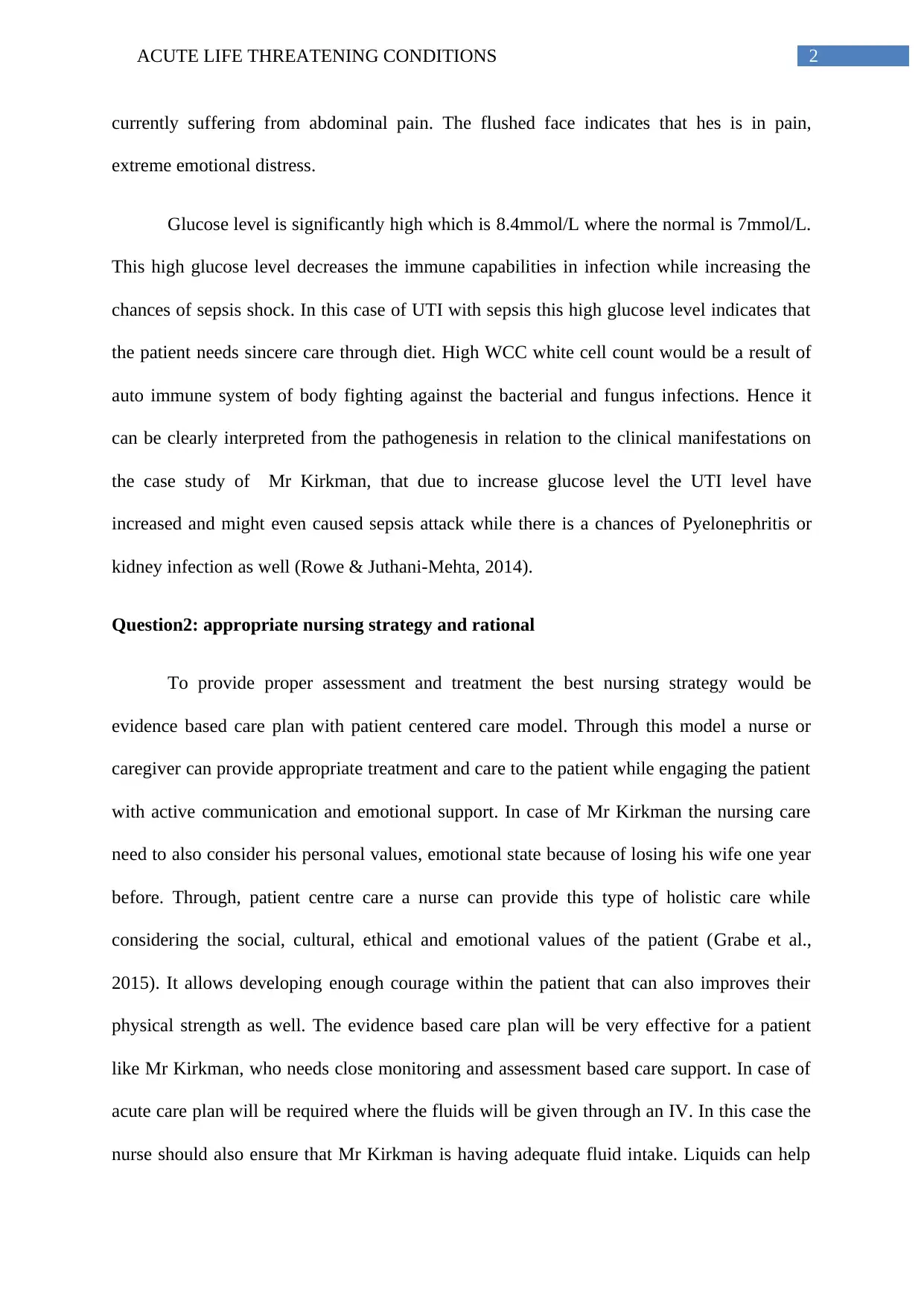
2ACUTE LIFE THREATENING CONDITIONS
currently suffering from abdominal pain. The flushed face indicates that hes is in pain,
extreme emotional distress.
Glucose level is significantly high which is 8.4mmol/L where the normal is 7mmol/L.
This high glucose level decreases the immune capabilities in infection while increasing the
chances of sepsis shock. In this case of UTI with sepsis this high glucose level indicates that
the patient needs sincere care through diet. High WCC white cell count would be a result of
auto immune system of body fighting against the bacterial and fungus infections. Hence it
can be clearly interpreted from the pathogenesis in relation to the clinical manifestations on
the case study of Mr Kirkman, that due to increase glucose level the UTI level have
increased and might even caused sepsis attack while there is a chances of Pyelonephritis or
kidney infection as well (Rowe & Juthani-Mehta, 2014).
Question2: appropriate nursing strategy and rational
To provide proper assessment and treatment the best nursing strategy would be
evidence based care plan with patient centered care model. Through this model a nurse or
caregiver can provide appropriate treatment and care to the patient while engaging the patient
with active communication and emotional support. In case of Mr Kirkman the nursing care
need to also consider his personal values, emotional state because of losing his wife one year
before. Through, patient centre care a nurse can provide this type of holistic care while
considering the social, cultural, ethical and emotional values of the patient (Grabe et al.,
2015). It allows developing enough courage within the patient that can also improves their
physical strength as well. The evidence based care plan will be very effective for a patient
like Mr Kirkman, who needs close monitoring and assessment based care support. In case of
acute care plan will be required where the fluids will be given through an IV. In this case the
nurse should also ensure that Mr Kirkman is having adequate fluid intake. Liquids can help
currently suffering from abdominal pain. The flushed face indicates that hes is in pain,
extreme emotional distress.
Glucose level is significantly high which is 8.4mmol/L where the normal is 7mmol/L.
This high glucose level decreases the immune capabilities in infection while increasing the
chances of sepsis shock. In this case of UTI with sepsis this high glucose level indicates that
the patient needs sincere care through diet. High WCC white cell count would be a result of
auto immune system of body fighting against the bacterial and fungus infections. Hence it
can be clearly interpreted from the pathogenesis in relation to the clinical manifestations on
the case study of Mr Kirkman, that due to increase glucose level the UTI level have
increased and might even caused sepsis attack while there is a chances of Pyelonephritis or
kidney infection as well (Rowe & Juthani-Mehta, 2014).
Question2: appropriate nursing strategy and rational
To provide proper assessment and treatment the best nursing strategy would be
evidence based care plan with patient centered care model. Through this model a nurse or
caregiver can provide appropriate treatment and care to the patient while engaging the patient
with active communication and emotional support. In case of Mr Kirkman the nursing care
need to also consider his personal values, emotional state because of losing his wife one year
before. Through, patient centre care a nurse can provide this type of holistic care while
considering the social, cultural, ethical and emotional values of the patient (Grabe et al.,
2015). It allows developing enough courage within the patient that can also improves their
physical strength as well. The evidence based care plan will be very effective for a patient
like Mr Kirkman, who needs close monitoring and assessment based care support. In case of
acute care plan will be required where the fluids will be given through an IV. In this case the
nurse should also ensure that Mr Kirkman is having adequate fluid intake. Liquids can help
⊘ This is a preview!⊘
Do you want full access?
Subscribe today to unlock all pages.

Trusted by 1+ million students worldwide

3ACUTE LIFE THREATENING CONDITIONS
flush bacteria from the urinary system. Keeping proper medication for antibiotics and eating,
diet, and nutrition play a role in preventing or treating bladder infections. Changing catheter
to reduce instrumental infection will be very helpful (Meddings et al., 2015).
Question3: Arterial blood gas results and relation to the underlying pathogenesis
As per the Arterial blood gases or ABG test it has been found that pH level is lower than the
normal range. This low PH indicates the problem of acidosis, where the acidic level of the
body is higher than the balanced level. Hence, to examine the type of acidosis the analysis of
HCO3 is essential. In this case, the HCO3 is also very low than the normal level. Hence, low
PH indicates acidosis and Low HCO3 indicates Metabolic acidosis. To ensure this fact other
Arterial blood factors need to be considered as well that includes the consideration of Kiton,
lactate and Base Excess or BE. From the ABG test report it has been found that PaCO2 as
well as BE are lower than the normal range. On the other hand the Ketone level is unknown.
Hence to anticipate this unknown measure Anion Gap needs to be measured. The Anion Gap
in blood is measured by AG= ([Na+] + [K+]) – ([Cl–] + [HCO3‾]).
From the Electrolytes , urea & creatinine (EUC) test it has been found that sodium ain level is
higher than normal 148mmol/L. High level of sodiam can also idicates Hypernatremia which
involves dehydration. The potasiam level is also higher than normal range which is 5.2
mmol/L. High level potasiam in blood could be a result of hyperkalemia or kidney issues.
Chlorine level is 111 mmol/L slightly higher than the normal range. Hence according to the
above stated formula the Anion Gap is (148+5.2-111+15)=57.2 mmol/L. According to the
Anion Gap scale the normal range of AG is 10mmol/L to 18mmol/L. Hence, it can be clearly
seen that the Ketone level must be high because of this extremely high AG level of the
patient. Low PH acidosis , Low PaCO2 and low HCO3‾ with low BE in a diabetic patient
flush bacteria from the urinary system. Keeping proper medication for antibiotics and eating,
diet, and nutrition play a role in preventing or treating bladder infections. Changing catheter
to reduce instrumental infection will be very helpful (Meddings et al., 2015).
Question3: Arterial blood gas results and relation to the underlying pathogenesis
As per the Arterial blood gases or ABG test it has been found that pH level is lower than the
normal range. This low PH indicates the problem of acidosis, where the acidic level of the
body is higher than the balanced level. Hence, to examine the type of acidosis the analysis of
HCO3 is essential. In this case, the HCO3 is also very low than the normal level. Hence, low
PH indicates acidosis and Low HCO3 indicates Metabolic acidosis. To ensure this fact other
Arterial blood factors need to be considered as well that includes the consideration of Kiton,
lactate and Base Excess or BE. From the ABG test report it has been found that PaCO2 as
well as BE are lower than the normal range. On the other hand the Ketone level is unknown.
Hence to anticipate this unknown measure Anion Gap needs to be measured. The Anion Gap
in blood is measured by AG= ([Na+] + [K+]) – ([Cl–] + [HCO3‾]).
From the Electrolytes , urea & creatinine (EUC) test it has been found that sodium ain level is
higher than normal 148mmol/L. High level of sodiam can also idicates Hypernatremia which
involves dehydration. The potasiam level is also higher than normal range which is 5.2
mmol/L. High level potasiam in blood could be a result of hyperkalemia or kidney issues.
Chlorine level is 111 mmol/L slightly higher than the normal range. Hence according to the
above stated formula the Anion Gap is (148+5.2-111+15)=57.2 mmol/L. According to the
Anion Gap scale the normal range of AG is 10mmol/L to 18mmol/L. Hence, it can be clearly
seen that the Ketone level must be high because of this extremely high AG level of the
patient. Low PH acidosis , Low PaCO2 and low HCO3‾ with low BE in a diabetic patient
Paraphrase This Document
Need a fresh take? Get an instant paraphrase of this document with our AI Paraphraser
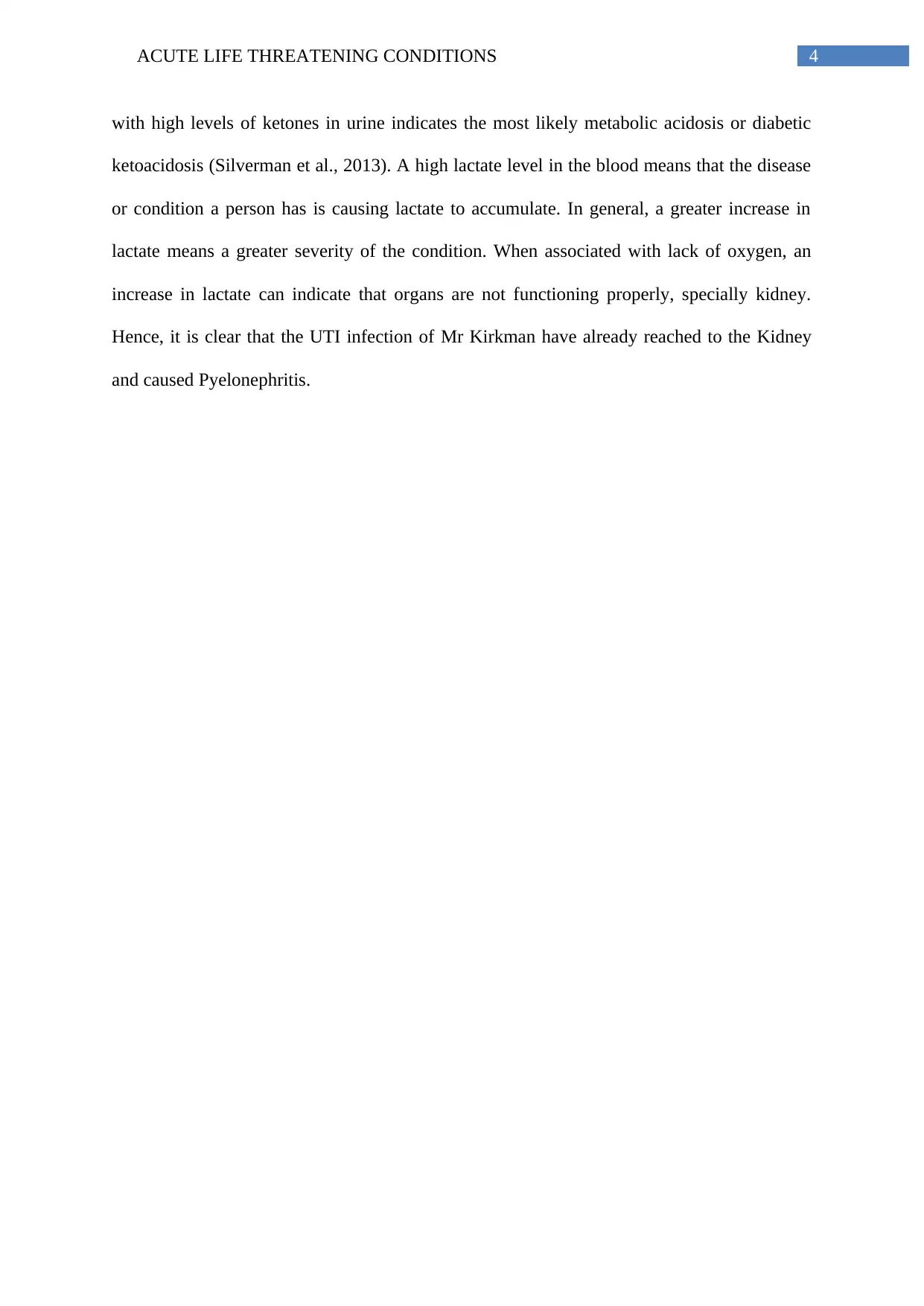
4ACUTE LIFE THREATENING CONDITIONS
with high levels of ketones in urine indicates the most likely metabolic acidosis or diabetic
ketoacidosis (Silverman et al., 2013). A high lactate level in the blood means that the disease
or condition a person has is causing lactate to accumulate. In general, a greater increase in
lactate means a greater severity of the condition. When associated with lack of oxygen, an
increase in lactate can indicate that organs are not functioning properly, specially kidney.
Hence, it is clear that the UTI infection of Mr Kirkman have already reached to the Kidney
and caused Pyelonephritis.
with high levels of ketones in urine indicates the most likely metabolic acidosis or diabetic
ketoacidosis (Silverman et al., 2013). A high lactate level in the blood means that the disease
or condition a person has is causing lactate to accumulate. In general, a greater increase in
lactate means a greater severity of the condition. When associated with lack of oxygen, an
increase in lactate can indicate that organs are not functioning properly, specially kidney.
Hence, it is clear that the UTI infection of Mr Kirkman have already reached to the Kidney
and caused Pyelonephritis.

5ACUTE LIFE THREATENING CONDITIONS
References:
Flores-Mireles, A. L., Walker, J. N., Caparon, M., & Hultgren, S. J. (2015). Urinary tract
infections: epidemiology, mechanisms of infection and treatment options. Nature
reviews microbiology, 13(5), 269.
Foxman, B. (2014). Urinary tract infection syndromes: occurrence, recurrence, bacteriology,
risk factors, and disease burden. Infectious disease clinics of North America, 28(1), 1-
13.
Grabe, M., Bjerklund-Johansen, T. E., Botto, H., Çek, M., Naber, K. G., Tenke, P., &
Wagenlehner, F. (2015). Guidelines on urological infections. European association of
urology, 182.
Meddings, J., Rogers, M. A., Krein, S. L., Fakih, M. G., Olmsted, R. N., & Saint, S. (2014).
Reducing unnecessary urinary catheter use and other strategies to prevent catheter-
associated urinary tract infection: an integrative review. BMJ Qual Saf, 23(4), 277-
289.
Mnif, M. F., Kamoun, M., Kacem, F. H., Bouaziz, Z., Charfi, N., Mnif, F., ... & Abid, M.
(2013). Complicated urinary tract infections associated with diabetes mellitus:
Pathogenesis, diagnosis and management. Indian journal of endocrinology and
metabolism, 17(3), 442.
References:
Flores-Mireles, A. L., Walker, J. N., Caparon, M., & Hultgren, S. J. (2015). Urinary tract
infections: epidemiology, mechanisms of infection and treatment options. Nature
reviews microbiology, 13(5), 269.
Foxman, B. (2014). Urinary tract infection syndromes: occurrence, recurrence, bacteriology,
risk factors, and disease burden. Infectious disease clinics of North America, 28(1), 1-
13.
Grabe, M., Bjerklund-Johansen, T. E., Botto, H., Çek, M., Naber, K. G., Tenke, P., &
Wagenlehner, F. (2015). Guidelines on urological infections. European association of
urology, 182.
Meddings, J., Rogers, M. A., Krein, S. L., Fakih, M. G., Olmsted, R. N., & Saint, S. (2014).
Reducing unnecessary urinary catheter use and other strategies to prevent catheter-
associated urinary tract infection: an integrative review. BMJ Qual Saf, 23(4), 277-
289.
Mnif, M. F., Kamoun, M., Kacem, F. H., Bouaziz, Z., Charfi, N., Mnif, F., ... & Abid, M.
(2013). Complicated urinary tract infections associated with diabetes mellitus:
Pathogenesis, diagnosis and management. Indian journal of endocrinology and
metabolism, 17(3), 442.
⊘ This is a preview!⊘
Do you want full access?
Subscribe today to unlock all pages.

Trusted by 1+ million students worldwide
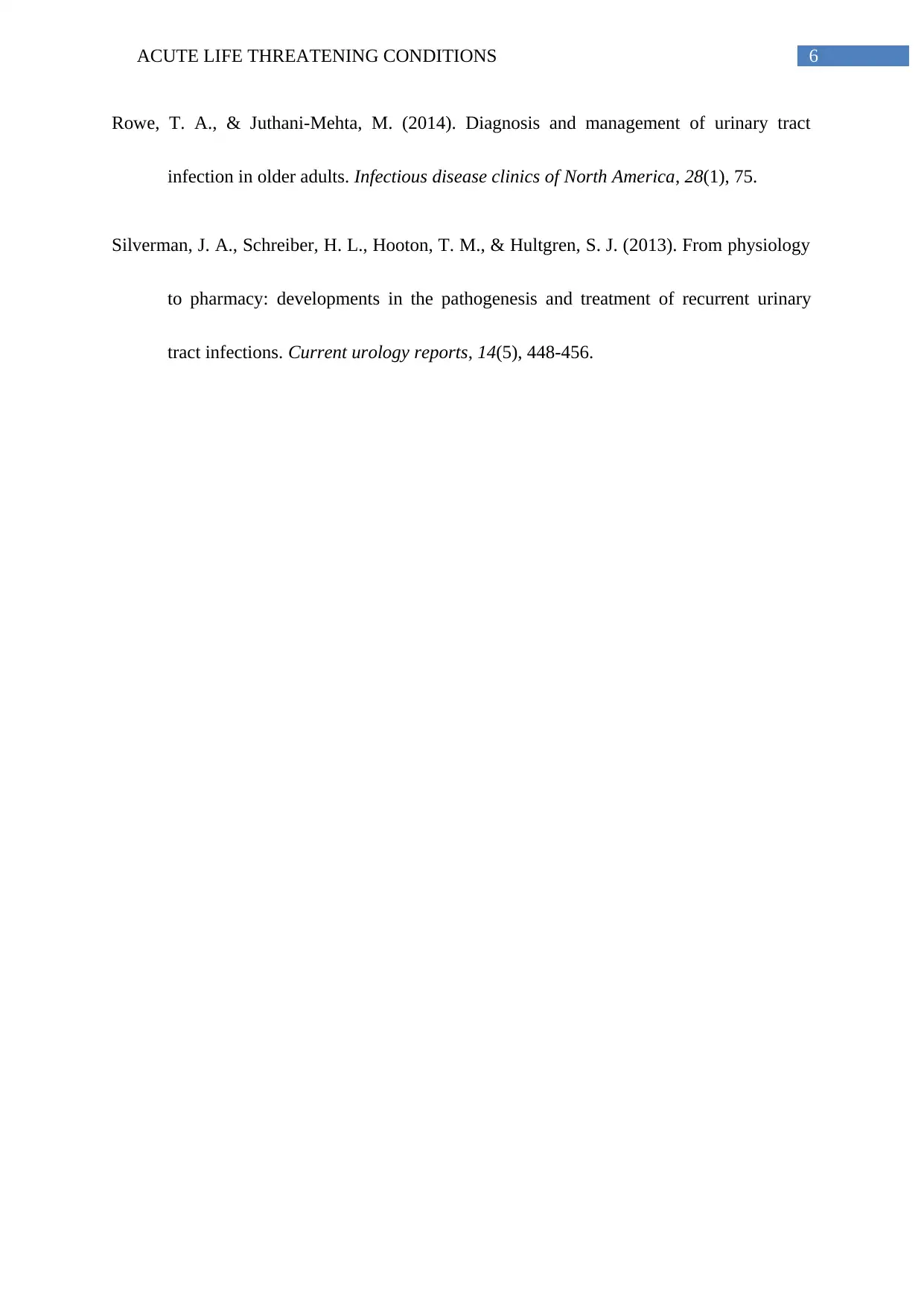
6ACUTE LIFE THREATENING CONDITIONS
Rowe, T. A., & Juthani-Mehta, M. (2014). Diagnosis and management of urinary tract
infection in older adults. Infectious disease clinics of North America, 28(1), 75.
Silverman, J. A., Schreiber, H. L., Hooton, T. M., & Hultgren, S. J. (2013). From physiology
to pharmacy: developments in the pathogenesis and treatment of recurrent urinary
tract infections. Current urology reports, 14(5), 448-456.
Rowe, T. A., & Juthani-Mehta, M. (2014). Diagnosis and management of urinary tract
infection in older adults. Infectious disease clinics of North America, 28(1), 75.
Silverman, J. A., Schreiber, H. L., Hooton, T. M., & Hultgren, S. J. (2013). From physiology
to pharmacy: developments in the pathogenesis and treatment of recurrent urinary
tract infections. Current urology reports, 14(5), 448-456.
1 out of 7
Related Documents
Your All-in-One AI-Powered Toolkit for Academic Success.
+13062052269
info@desklib.com
Available 24*7 on WhatsApp / Email
![[object Object]](/_next/static/media/star-bottom.7253800d.svg)
Unlock your academic potential
Copyright © 2020–2025 A2Z Services. All Rights Reserved. Developed and managed by ZUCOL.





